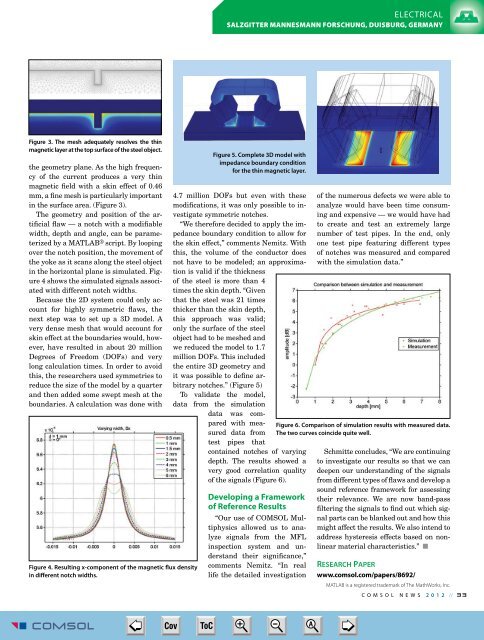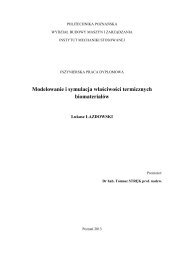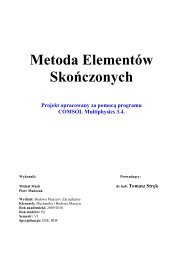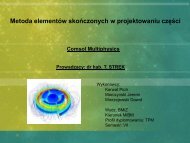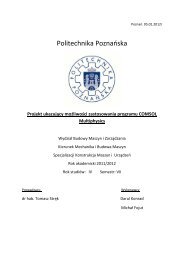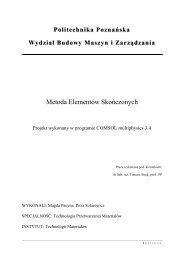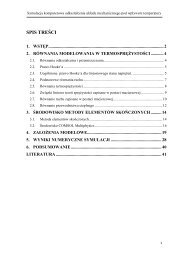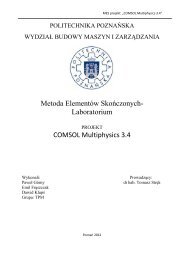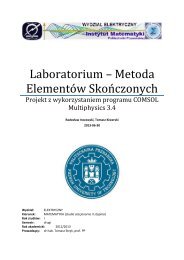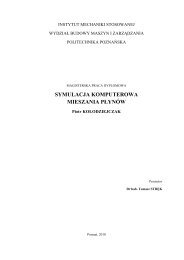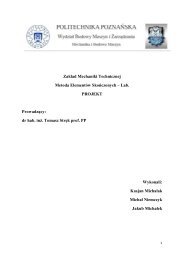COMSOL News
COMSOL News
COMSOL News
Create successful ePaper yourself
Turn your PDF publications into a flip-book with our unique Google optimized e-Paper software.
ELECTRICAL<br />
SALZGITTER MANNESMANN FORSCHUNG, DUISBURG, GERMANY<br />
Figure 3. The mesh adequately resolves the thin<br />
magnetic layer at the top surface of the steel object.<br />
the geometry plane. As the high frequency<br />
of the current produces a very thin<br />
magnetic field with a skin effect of 0.46<br />
mm, a fine mesh is particularly important<br />
in the surface area. (Figure 3).<br />
The geometry and position of the artificial<br />
flaw — a notch with a modifiable<br />
width, depth and angle, can be parameterized<br />
by a MATLAB ® script. By looping<br />
over the notch position, the movement of<br />
the yoke as it scans along the steel object<br />
in the horizontal plane is simulated. Figure<br />
4 shows the simulated signals associated<br />
with different notch widths.<br />
Because the 2D system could only account<br />
for highly symmetric flaws, the<br />
next step was to set up a 3D model. A<br />
very dense mesh that would account for<br />
skin effect at the boundaries would, however,<br />
have resulted in about 20 million<br />
Degrees of Freedom (DOFs) and very<br />
long calculation times. In order to avoid<br />
this, the researchers used symmetries to<br />
reduce the size of the model by a quarter<br />
and then added some swept mesh at the<br />
boundaries. A calculation was done with<br />
Figure 4. Resulting x-component of the magnetic flux density<br />
in different notch widths.<br />
Figure 5. Complete 3D model with<br />
impedance boundary condition<br />
for the thin magnetic layer.<br />
4.7 million DOFs but even with these<br />
modifications, it was only possible to investigate<br />
symmetric notches.<br />
“We therefore decided to apply the impedance<br />
boundary condition to allow for<br />
the skin effect,” comments Nemitz. With<br />
this, the volume of the conductor does<br />
not have to be modeled; an approximation<br />
is valid if the thickness<br />
of the steel is more than 4<br />
times the skin depth. “Given<br />
that the steel was 21 times<br />
thicker than the skin depth,<br />
this approach was valid;<br />
only the surface of the steel<br />
object had to be meshed and<br />
we reduced the model to 1.7<br />
million DOFs. This included<br />
the entire 3D geometry and<br />
it was possible to define arbitrary<br />
notches.” (Figure 5)<br />
To validate the model,<br />
data from the simulation<br />
data was compared<br />
with measured<br />
data from<br />
test pipes that<br />
contained notches of varying<br />
depth. The results showed a<br />
very good correlation quality<br />
of the signals (Figure 6).<br />
Developing a Framework<br />
of Reference Results<br />
“Our use of <strong>COMSOL</strong> Multiphysics<br />
allowed us to analyze<br />
signals from the MFL<br />
inspection system and understand<br />
their significance,”<br />
comments Nemitz. “In real<br />
life the detailed investigation<br />
of the numerous defects we were able to<br />
analyze would have been time consuming<br />
and expensive — we would have had<br />
to create and test an extremely large<br />
number of test pipes. In the end, only<br />
one test pipe featuring different types<br />
of notches was measured and compared<br />
with the simulation data.”<br />
Figure 6. Comparison of simulation results with measured data.<br />
The two curves coincide quite well.<br />
Schmitte concludes, “We are continuing<br />
to investigate our results so that we can<br />
deepen our understanding of the signals<br />
from different types of flaws and develop a<br />
sound reference framework for assessing<br />
their relevance. We are now band-pass<br />
filtering the signals to find out which signal<br />
parts can be blanked out and how this<br />
might affect the results. We also intend to<br />
address hysteresis effects based on nonlinear<br />
material characteristics.” n<br />
RESEARCH PAPER<br />
www.comsol.com/papers/8692/<br />
MATLAB is a registered trademark of The MathWorks, Inc.<br />
<strong>COMSOL</strong> NEWS 2 0 1 2 // 3 3<br />
<strong>COMSOL</strong> <strong>News</strong> 2012-17.indd 33<br />
➮<br />
Cov ToC + – A<br />
➭<br />
5/15/12 4:27 PM


